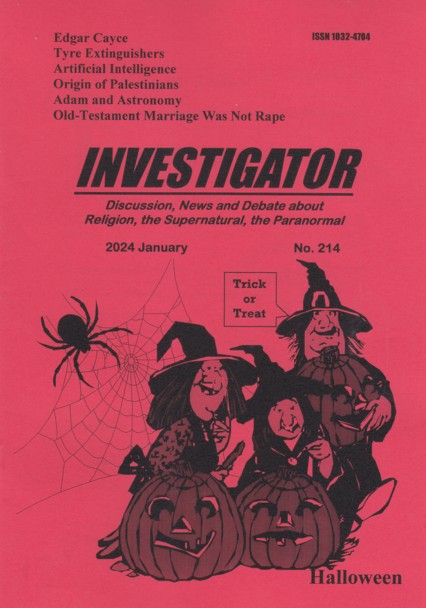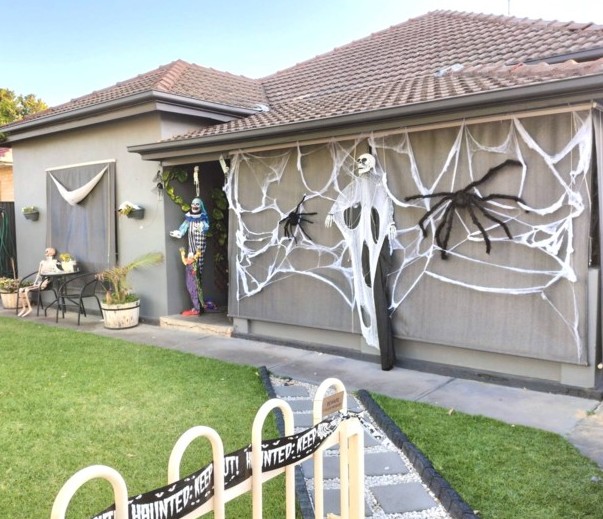HALLOWEEN
(Investigator #214, 2024 January)
(Investigator #214, 2024 January)

This image: From IMSI's MasterClips/MasterPhotos 202,000 © 1997 Collection,
1895 Francisco Blvd. East, San Rafael, CA 94901-5506, USA
1895 Francisco Blvd. East, San Rafael, CA 94901-5506, USA

Halloween, October 31, is associated with ghosts, skeletons, vampires, giant spiders, demons, martyrdom, death and other spooky, horrid and scary phenomena.
The festival is celebrated around the world with costume parties; visits to haunted places; bonfires; pranks; watching Halloween-themed movies; lighting candles on graves in cemeteries; divination; eating vegetarian foods such as potato pancakes; Trick-or-treating; and house-front displays (of ghosts, spiders, skeletons, cobwebs, tombstones, skulls and witches.)
The origins of Halloween trace back to pagan, Celtic harvest festivals in Ireland and Scotland, and Germanic remembrances of the dead, which were Christianized by the early Church. A feast commemorating Christian saints and martyrs was commemorated in Ireland on November 1 already in the 8th century.
Customs and practices came and went as centuries passed and included church-bell ringing, street parades to remember the dead, sharing of cakes, going door-to-door to ask for gifts of food, carrying lanterns and singing, leaving food outside for ghosts, prayers for souls, and wearing of costumes. In recent decades imagery from horror movies have been added to Halloween including Dracula, Frankenstein and The Mummy. In America the carving of pumpkins into masks, or scooped out to make lanterns, became popular in the late 19th century.
The English word "Halloween" comes from "All Hallows Eve" which is the designation for the evening vigil held prior to All Saints' Day (November 1st) and All Souls' Day (November 2).
The celebrations and customs spread through Europe, were taken to America by immigrants in the 19th century, and spread world-wide in the late 20th century.
The world's biggest Halloween event is the New York Halloween Parade started in 1974 which has had 60,000 costumed participants and 2 million spectators.
Halloween costumes in parades or at parties are modeled after traditional notions of ghosts, vampires, witches, devils, and zombies, and have started to include ninjas, aliens and fairies.
Since the 1990s haunted houses and themed parks, opened seasonally, where people pay to feel frightened, have been operated by businesses in the US.
Many people commemorate the festival from a non-religious, secular viewpoint, just for fun without taking its supernatural themes seriously.
Trick-or-treaters
Trick-or-treating became widespread in the USA beginning in the 1930s and has been taken up in Australia. Children, often in costume, go house to house and ask "Trick or treat" — where "trick" implies a threat of mischief if no "treat" such as candy, fruit or money is given. The word "Children" is not limited to small kids but can include big ones. An 18-year old Foodland employee assured me she still does it.
Parties
Foods associated with Halloween parties include:
• Toffee apples
• Candy/Sweets
• Chocolate
• Peanuts
• Caramel coated corn
• Halloween cakes
• Novelty candy shaped like skulls, bats, worms, etc.
• Roasted sweet corn
• Pumpkin Pie
Common Halloween party-games include:
• Apple bobbing in which apples float in a basin of water and participants get wet faces by removing them with their teeth.
• Eating syrup-coated scones suspended on strings without using one's hands, resulting in grimy/sticky cheeks.
• Nut roasting over a fire.
• Various fortune-telling and divination routines.
Other pastimes include:
• Telling ghost stories.
• Halloween-themed songs.
• Watching horror movies and Halloween-themed specials.
Watching scary movies can be fun because the fear feels genuine and the screams and shivers of viewers are real, but objectively everyone knows they're safe. But a movie might feature a Halloween event where a costumed intruder is a psychopath about to start slashing, and so the movie watchers cast nervous glances at "ghosts" and "zombies" viewing with them.
Christian Attitudes
Christian attitudes towards Halloween vary.
Some regard it as merely a harmless once-a-year game night.
Others celebrate the day but emphasize Christian traditions, beliefs and practices. Rather than dressing up as ghosts or zombies children and parents might dress up as Bible characters. Candy and cakes might include Bible quotes. The response to "trick or treat" may include a gospel tract as part of the "treat". Halloween thus becomes an opportunity for evangelism.
Some groups regard Halloween as celebrating paganism and the occult, as a spiritual danger and avenue for demonic forces to exert an influence.
Jehovah's Witnesses and some other sects regard Halloween as a pagan celebration. They cite Deuteronomy 18:10-11 which warns the Israelites against divination, spells, sorcery, ghosts and spirits; and Galatians 5:19-21 which warns against "drunkenness [and] carousing" apparently referring to parties where control is lost.
Jews and Muslims often avoid involvement in Halloween for similar reasons.
Numbers
Halloween has gone worldwide. Australia's Sunday Mail (October 22) reported that in Australia alone 5.3 million people would celebrate it in 2023, spending on it $490m which is $60m more than in 2022.
Of the alleged 5.3 million only a small proportion appear interested enough to set up a Halloween-themed display in front of their house. I estimated this by taking five walks from my home in different directions, counted the number of houses passed, and the number with a front-yard Halloween display.
The result was 2.4% as follows:
| Houses Counted | Displays Counted |
| 70 |
5 |
| 100 |
7 |
| 200 |
5 |
| 200 |
1 |
| 190 |
2 |
| Total |
Total |
| 760 |
20 [= 2.4%] |
https://en.wikipedia.org/wiki/Halloween
BS